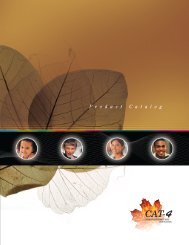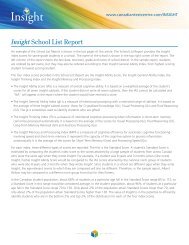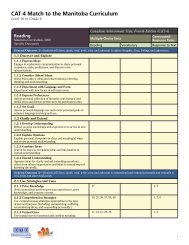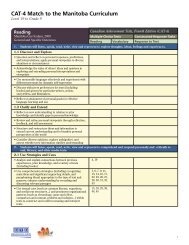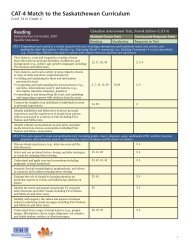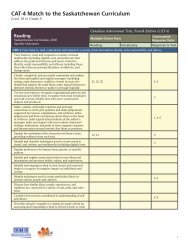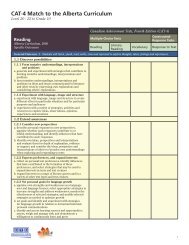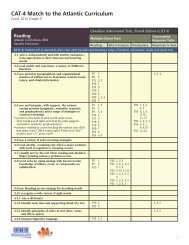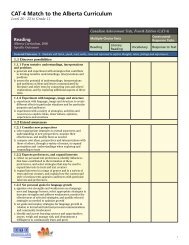CATâ4 Match to the Manitoba Curriculum - Canadian Test Centre
CATâ4 Match to the Manitoba Curriculum - Canadian Test Centre
CATâ4 Match to the Manitoba Curriculum - Canadian Test Centre
Create successful ePaper yourself
Turn your PDF publications into a flip-book with our unique Google optimized e-Paper software.
CAT∙4 <strong>Match</strong> <strong>to</strong> <strong>the</strong> Mani<strong>to</strong>ba <strong>Curriculum</strong><br />
Level 17 <strong>to</strong> Grade 7<br />
Writing<br />
Mani<strong>to</strong>ba <strong>Curriculum</strong>, 2000<br />
General and Specific Outcomes<br />
<strong>Canadian</strong> Achievement <strong>Test</strong>s, Fourth Edition (CAT·4)<br />
Multiple-Choice <strong>Test</strong>s<br />
Writing<br />
Spelling<br />
Conventions<br />
Constructed-Response Tasks<br />
Writing<br />
General Outcome 2—Students will listen, speak, read, write, view and represent <strong>to</strong> comprehend and respond personally and critically <strong>to</strong><br />
oral, print and o<strong>the</strong>r media texts.<br />
2.1 Use Strategies and Cues<br />
2.1.1 Prior Knowledge<br />
Explain connections between previous experiences, prior<br />
knowledge, and a variety of texts.<br />
2.1.2 Comprehension Strategies<br />
Use comprehension strategies [including reflecting on and<br />
assessing meaning, skimming, scanning, close reading,<br />
and identifying and relating in own words <strong>the</strong> main and<br />
supporting ideas] appropriate <strong>to</strong> <strong>the</strong> type of text and<br />
purpose; use a variety of strategies <strong>to</strong> remember ideas.<br />
2.1.3 Textual Cues<br />
Use textual cues <strong>to</strong> construct and confirm meaning and<br />
interpret texts.<br />
2.1.4 Cueing Systems<br />
Use syntactic, semantic, and graphophonic cueing systems<br />
[including word order; context clues and multiple meanings<br />
of words; structural analysis <strong>to</strong> identify roots, prefixes, and<br />
suffixes] <strong>to</strong> construct and confirm meaning and interpret<br />
texts [including meaning of specialized vocabulary].<br />
2.2 Respond <strong>to</strong> Texts<br />
2.2.1 Experience Various Texts<br />
Experience texts from a variety of forms and genres and<br />
cultural traditions; discuss likes and dislikes.<br />
2.2.2 Connect Self, Texts, and Culture<br />
Compare own with o<strong>the</strong>rs’ understanding of people, cultural<br />
traditions, and values portrayed in oral, literary, and media<br />
texts [including texts about Canada or by <strong>Canadian</strong> writers].<br />
2.2.3 Appreciate <strong>the</strong> Artistry of Texts<br />
Identify language and visual images that create mood and<br />
evoke emotion in oral, literary, and media texts.<br />
2.3 Understand forms and genres<br />
2.3.1 Forms and Genre<br />
Explain preferences for particular forms and genres of oral,<br />
literary, and media texts<br />
2.3.2 Techniques and Elements<br />
Examine techniques of plot development and of persuasion<br />
in oral, literary, and media texts.<br />
2.3.3 Vocabulary<br />
Recognize uses and abuses of slang, colloquialism, and<br />
jargon.<br />
2.3.4 Experiment with Language<br />
Identify surprising and playful uses of language in oral,<br />
literary, and media texts; explain ways in which figures of<br />
speech convey meaning.<br />
17, 18, 19, 20,<br />
21, 22<br />
6



